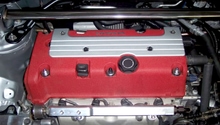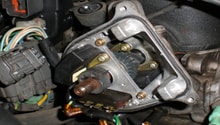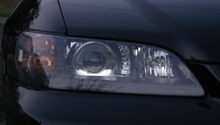Honda Accord: Why Won't My Car Start?
What you need to know about car ignition problems and how to fix them.
This article applies to the Honda Accord (1990-2002).
Four main processes (among others) must occur for a car to start: the ignition system must deliver an electric spark across the spark plug gap; the car's battery must deliver sufficient energy, which is measured in volts, to power the vehicle across distances; the car's electrical and mechanical systems, which are comprised of a number of moving parts and performance components, must all be in good working order; and the vehicle itself must have sufficient fuel for the engine to run. If any one of these four main processes does not occur in time, your car will not start. While some fixes are easy and can be performed using everyday tools from your home garage, others are best left to the professionals at a local Honda dealer.

Materials Needed
- Open-end wrench
- Wire brush
- Corrosion removal product
- New battery
- Multireader or universal automotive diagnostic tool
Step 1 – Test the battery with a portable battery tester
The most common reason your car won't start is because the battery is not producing enough electric energy or "cranking amps" to run the engine. When the ignition is turned on, the battery should deliver a minimum of 12 volts to start the engine.
- Jump-start the battery to test if the vehicle will start. If it does, you most likely are dealing with a weak battery.
- If corrosion is present, clean the battery posts using a premium corrosion removal product, which you can find at your local auto parts store.
- Remember to first disconnect the battery cables using an open-end wrench.
- After spraying the battery with the corrosion removal fluid, brush away deposits using a wire brush.
- If you do not own a battery tester, have the vehicle towed to a local mechanic, where the battery can be tested and replaced for around $120.
Pro Tip
Always remove the negative battery cable first.
Step 2 – Test the alternator
If after jump-starting the car you hear a squealing sound coming from under the hood of your car, you are most likely dealing with a faulty alternator. For a final check, rev the engine. If a fuzzy sound emanates from the radio or the alternator feels hot to the touch, then the alternator is defective and needs to be replaced. Alternatively, if you have a multimeter, you can measure the voltage being supplied by the alternator; 7.6 V+ is a healthy area for the alternator. Touch one probe onto the battery, or a ground, and the other onto the alternator hot spot ("testing point") and measure the voltage output.
Step 3 – Check engine grounds
If there is in fact a bad ground connection, you would notice noise in the audio system. Another clear indication of a bad engine ground is an inoperable electrical system (i.e., a car that won't start).
- Trace the wiring using a volt meter that is set to read ohms or resistance.
- Test the battery's negative stud and ground connection.
- If the reading is less than five ohms, the ground is fine and not the culprit.

Step 4 – Test your spark plugs and wires
They might be loose or faulty. There are a few things to look out for when checking for defective spark plug wires:
- Check for actual physical damage to the wires, including heat damage and corrosion.
- Carry out a spark plug wire resistance test.
- The resistance of the wire should coincide with the resistance rating in your Honda service manual.
- Check the distributor cap for loose clips, which could prevent the wires from properly holding their position.
(Related Article: How to Replace Spark Plugs and Wires - Honda-Tech.com)

Step 5 – Replace the main relay
If the engine won't fire up at all, the main relay might need to be replaced.
- Test by connecting the multimeter to each terminal.
- Replace if terminals are closing and battery voltage is not available across all locations.

Related Discussions
- Honda Accord Won't Start - Honda-Tech.com
- Car Starts and Dies - Honda-Tech.com






